Introduction and steps of black oxidation surface treatment
What is black oxide coating?
It is a chemical conversion process that darkens the surface of a part without adding a thick coating. Unlike plating or coating, which adds a thicker layer on top of a substrate, the chemical conversion process uses a chemical solution to force a reaction on the surface of the part.
While black oxidation is most commonly applied to ferrous metals (ferrous metals), there are methods of black oxidizing other metals, such as copper and stainless steel, that are specifically designed to resist surface reactions. The finish is usually black or dark bluish black. It can be glossy or matte, depending on the pre-processing and post-conversion processes used after blackening.
Black oxide is known by several different names. Some names for similar black oxidation processes include black oxidation, blackening, bluing, cold bluing, and gun bluing. There are some subtle differences, which we’ll discuss later. Some sources incorrectly combine black phosphate and black oxidation processes. Both processes result in a darkening of the surface, but are not the same.
What is the process of black oxidation treatment?
The black process involves five main steps, which are:
1.Clean
Properly clean metal surfaces to remove contaminants such as grease, oil, rust or dirt. This step is critical to ensure proper adhesion of the black oxide coating.
2.Rinsing
After cleaning, rinse the metal to remove any remaining cleaner or debris. Rinsing helps prepare the surface for subsequent process steps.
3.Descaling/pickling
In this step, the metal is treated with a descaling or pickling solution to remove any scale, oxides, or other impurities from the surface. The aim is to create a clean and reactive surface for the subsequent blackening process.

4.Neutralize
This process is only required if the finished part has blind holes or is part of an assembly. This requires re-cleaning the parts with an alkaline solution. This will help prevent leaks, which can damage the surface of the part.
5.Stripping
This condition stage only occurs if the finished part is plated with another material (chromium, zinc, cadmium, etc.). The machinist must deplat the parts because the black oxide gun finish cannot be maintained on plated parts.
6.Oxidized black topcoat
This is where the machinist will ultimately perform surface preparation. Finished metal parts are immersed in tanks containing various alkaline solutions such as sodium hydroxide and nitrates. This stage has three temperatures used to determine the coating material on the part surface. This process leaves a magnetite coating (Fe90O120) on the part at both high temperatures (2°C) and low temperatures (3-141°C). However, this method deposits a copper-selenium coating (Cu2Se) on the part surface at low-temperature operating levels.
7.Finishing
Without post-processing, finished parts are still susceptible to corrosion. However, this rule does not apply to surfaces made of black oxidized stainless steel or brass. This is because these metals are naturally resistant to corrosion. However, with other metal parts, post-processing is crucial. Oils, waxes and lacquers are popular back finishing options.
Oil is the most common after-treatment agent used by mechanics. It creates a smooth surface while also improving lubricity and corrosion resistance. Wax produces a duller surface but has excellent lubricating and anti-corrosion properties. Varnish is also a good choice, especially if you need to finish the part quickly.
